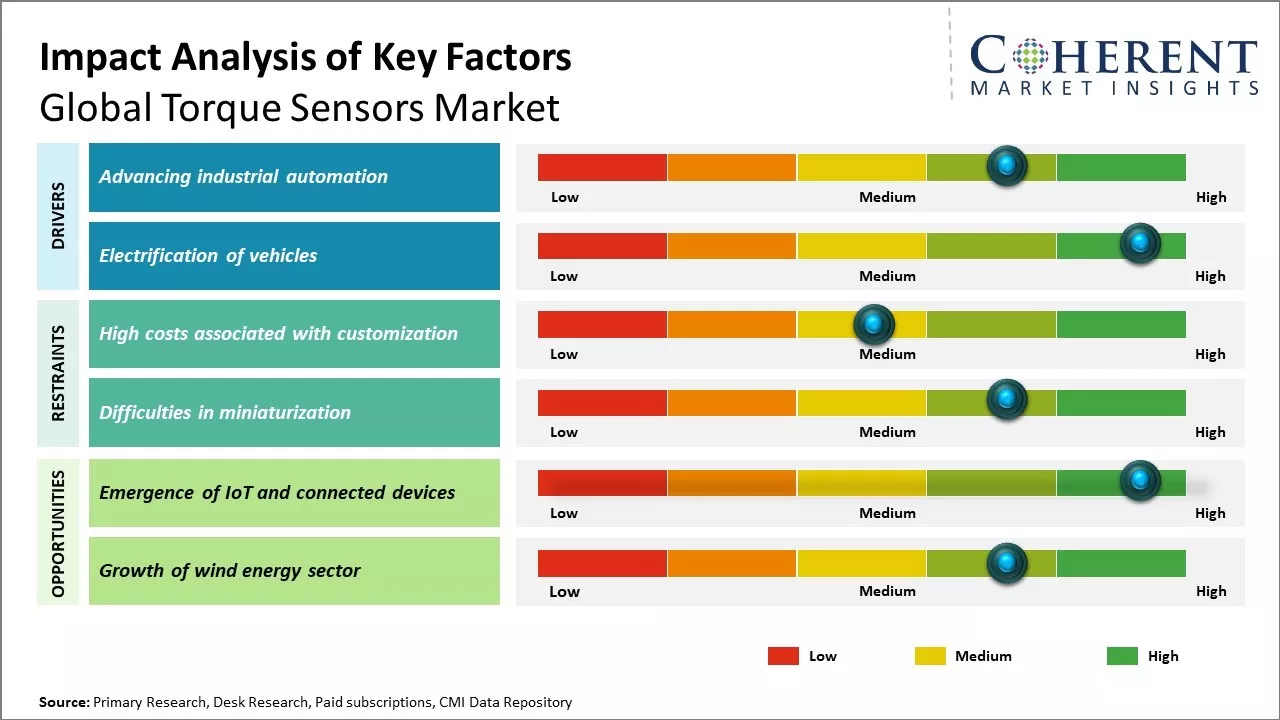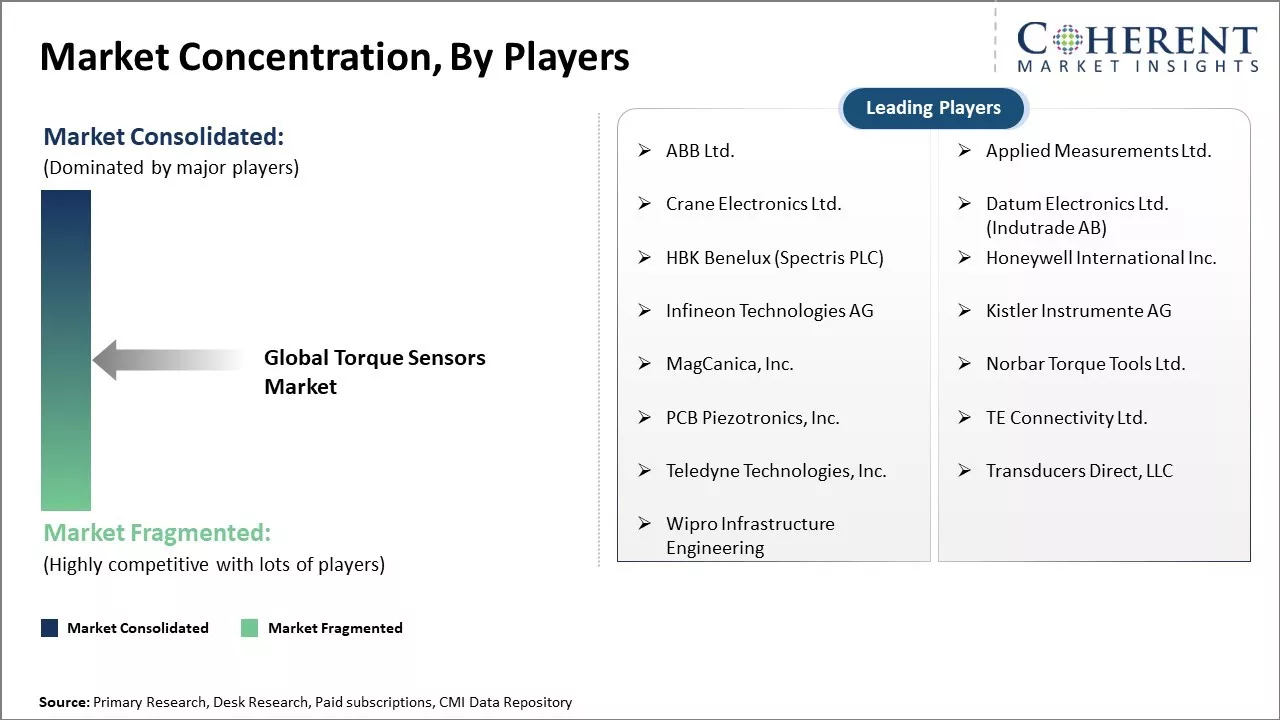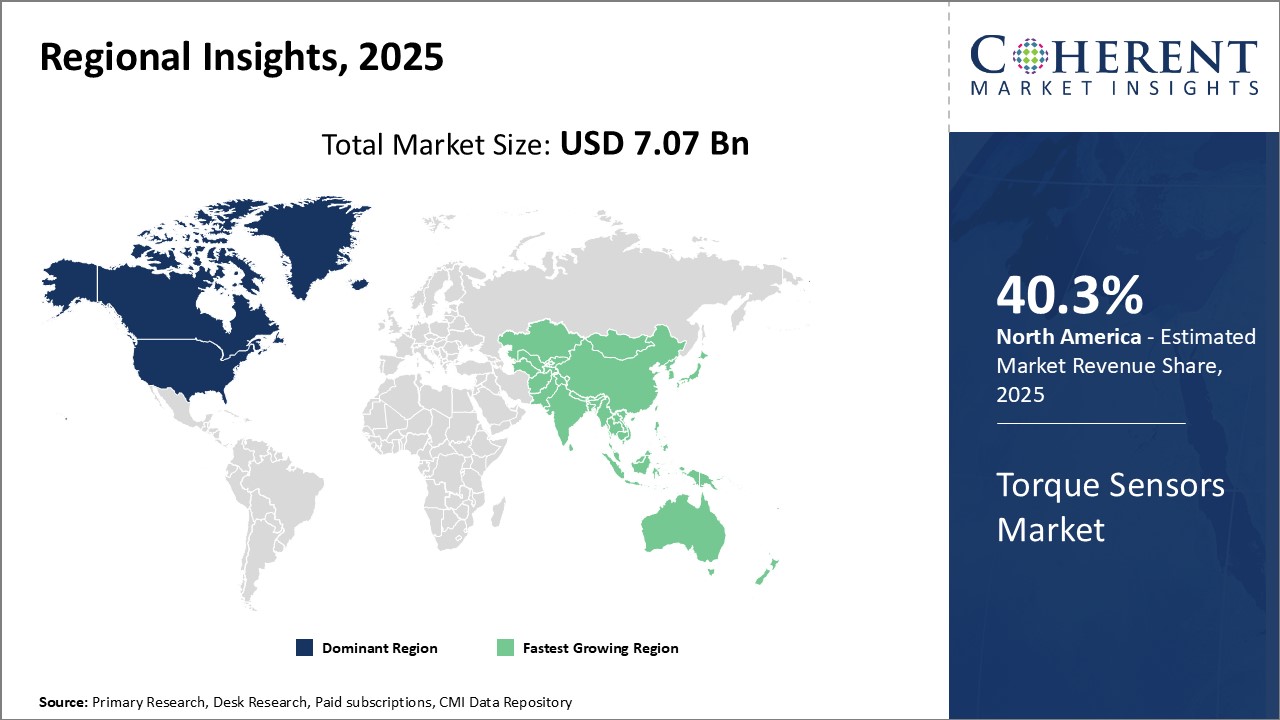Global torque sensors market is estimated to be valued at US$ 7.07 Bn in 2025 and is expected to reach US$ 11.37 Bn by 2032, exhibiting a compound annual growth rate (CAGR) of 7.0% from 2025 to 2032.

Discover market dynamics shaping the industry: Download Free Sample
Global torque sensors market is expected to witness positive growth over the forecast period due to growing demand for sensors from industrial robots. Torque sensors play a crucial role in industrial robots for measuring the torque on various joints during operations. The advantages of torque sensors in industrial robots such as high accuracy, compact size, and ability to withstand harsh environment further increases its usage. Growing industrial automation and adoption of collaborative robots or cobots across various industries including automotive, electronics, food & beverages, and packaging can boost demand for torque sensors during the forecast period. Rising focus on implementation of Industry 4.0 can offer opportunities for torque sensor manufacturers in the near future.
Advancing industrial automation
Torque sensors play a vital role in various automated industrial equipment and machinery by precisely measuring and monitoring torque levels during operations. These are increasingly being used in robotics and automated assembly lines to sense torque delivery and ensure product quality. Robotic arms and other industrial robotics require torque sensors for position and force control. Advanced manufacturing techniques like 3D printing also depend on torque sensing for additive manufacturing processes. Furthermore, sectors like automotive, food processing, and semiconductor manufacturing are automating more of their assembly and packaging steps, thus, boosting demand for torque transducers. Growing automation in areas like autonomous vehicles, collaborative robotics, and intelligent IoT devices can boost adoption of torque sensing technology. With industries striving to enhance productivity through labor-saving automation, the market for torque sensors will witness growth.

Get actionable strategies to beat competition: Download Free Sample
Electrification of vehicles
Rapid electrification in automotive sector can drive the market growth. As more automakers shift focus towards developing electric, hybrid, and fuel cell vehicles, there is increasing reliance on torque sensors compared to traditional combustion engines. Key EV components like motors, gearboxes, drivetrains and battery packs require precise torque measuring for optimum performance and safety. Torque sensor plays a vital role in smooth acceleration and efficient energy transmission in electric powertrains. Advanced driver-assistance systems and autonomous driving functionalities also depend on the accurate interpretation of drive train torque levels. Moreover, growing demand for alternators, starter motors and other auto parts with integrated torque detection can boost widespread usage of torque sensing technology. Hybridization of existing vehicles using technologies such as start-stop and mild hybridization can also boost demand for torque sensors. The electrification megatrend in the automotive industry provides a revenue stream for torque transducer manufacturers.
Key Takeaways from Analyst:
Global torque sensors market growth is driven by increasing uptake of autonomous and electric vehicles, demand for precision torque measurement across automotive drivetrains and rising manufacturing applications. Torque sensors play a vital role in ensuring safety and reliability in automated vehicle functions. Their ability to precisely measure torque parameters will be critical as autonomous driving functionalities become more sophisticated. Meanwhile, industrial sector also rely on torque sensors for quality control and preventive maintenance needs across machinery.
Ongoing global supply chain disruptions and chip shortages can hamper the market growth. Availability of key electronic components is a looming concern for torque sensor manufacturers. Furthermore, shifting economic conditions might dampen the otherwise upbeat demand scenario from the automotive aftermarket. The market might also witness pricing pressures, if raw material costs remain elevated. Integrating sensors with advanced connectivity features to support predictive maintenance through Industry 4.0 applications can offer market growth opportunities.
Presence of robust automotive manufacturing base as well as rising installations of industrial robots can drive the market growth. Meanwhile, rising autonomous EVs can boost demand for these sensors in Western Europe and North America.
Market Challenges: High costs associated with customization
High costs involved in developing customized solutions for unique applications can hamper wider adoption of torque sensors. Customizing torque sensors for niche applications requires extensive research and development efforts from manufacturers. Additional testing and certification procedures are also needed to ensure the customized sensors meet rigorous industry standards. This increases the cost significantly. For example, developing a highly customized and ruggedized torque sensor for downhole applications in the oil and gas industry can cost US$ 50,000 due to complex engineering challenges. Such high development expenditures have to be passed on to the customers as well. This makes customized torque sensors prohibitive for many cost-sensitive applications.
Moreover, long product development cycles needed for customization can also hamper the market growth. It can take 12-18 months for specialized torque sensors to be engineered as per the customer's exact specifications. This delays the time to market and does not allow manufacturers to quickly scale up production based on demand fluctuations. Thus, customized solutions appeal only to large corporations working on big-ticket projects who have the means to absorb high initial costs. According to the United Nations International Trade Statistics Database, exports of standard industrial process control and factory automation equipment had increased by over 6% year-on-year in 2021, indicating growing preference for generic solutions. High costs and long timelines involved in customization can present challenge for the torque sensors industry to penetrate new applications and markets.
Market Opportunities: Emergence of IoT and connected devices
The emergence of internet of things (IoT) and connected devices present a huge opportunity for the global torque sensor market. As more 'smart' devices get interconnected through IoT, there will be huge need for precise torque measurements. Torque sensors play a vital role in ensuring safety and performance in countless applications that involve rotational motion such as electric vehicles, industrial robots, power tools, and factory automation equipment. With rapid advancements in connectivity technologies like 5G, more devices across various industries will become a part of the IoT ecosystem.
IoT assisted solutions can help achieve predictive maintenance goals through early detection of component faults by continuous torque monitoring. This will make machinery uptime more efficient. The proliferation of connected devices presents a massive opportunity for torque sensor manufacturers to explore the need for specialized IoT integrated products across market verticals. Variants with integrated connectivity, compact packages suited for device miniaturization and enhanced durability can gain long term commercial success in the impending era of ubiquitous connectivity through IoT.

Discover high revenue pocket segments and roadmap to it: Download Free Sample
In terms of Product Type, Rotary Torque Sensors segment dominates due to increased adoption in automobile applications
By product type, rotary torque sensors segment is estimated to contribute the highest market share of 57.1% in 2025, due to their widespread adoption across the automotive industry. Automakers are increasingly incorporating rotary torque sensors in engine dynamometers, transmission assemblies, and battery packs to improve performance and efficiency.
These sensors allow precise torque measurement across rotating shafts and help automakers optimize engine calibration parameters. Automakers rely on rotary torque sensors to monitor torque loads during car manufacturing and perform quality checks. The sensors help flag issues and ensure chassis assemblies and powertrains meet stringent torque specifications. Furthermore, automakers are using rotary torque sensors integrated with electric vehicles to monitor battery health and implement battery management systems for optimal safety and life.
The popularity of hybrid and electric vehicles also boosts demand for high-accuracy rotary torque sensors. These next-gen vehicles require torque monitoring across multiple rotating components to effectively distribute power between the electric motor and combustion engine. As electric powertrains become more ubiquitous, automakers will continue investing in rotary torque sensing technology to improve reliability and efficiency.
The ability of rotary torque sensors to withstand harsh automotive environments while delivering precise, real-time torque readings has cemented their use across multiple vehicle assembly and testing applications.
In terms of Application- Automotive segment dominates
By application, automotive segment is estimated to contribute the highest market share of 43% in 2025 due to extensive monitoring needs across modern vehicle assembly and manufacturing operations. Automakers rely on precise torque measurement and control to ensure structural integrity and performance consistency.
Whether fastening chassis components or calibrating powertrain systems, automakers depend on torque feedback to guarantee specifications are achieved. Torque sensors integrated with manufacturing tools, like bolt tightening systems, also improve assembly ergonomics and reduce error. Proper torque application prevents issues like oil leaks, cracks, or fastener fatigue that could potentially lead to recalls.
As vehicles increasingly use electric motors and complex multi-gear transmissions, there is huge need for integrated torque sensors. These components require torque monitoring to distribute power efficiently and avoid damage during shifting. Automakers also use torque sensors for quality assurance testing after assembly to detect any issues before shipment.
Regulations requiring advanced safety features like electronic stability control can also drive the segment growth. These systems rely on torque sensors for functions like crash avoidance and all-wheel-drive distribution.

Need a Different Region or Segment? Download Free Sample
North America dominates the global torque sensors market with an estimated market share of 40.3% in 2025 owing to strong presence of key manufacturers in the U.S. and Canada. The region is home to world's leading automobile and industrial equipment manufacturers, which are major consumers of torque sensors. In terms of vehicle production, the U.S. alone accounts for over 15 million vehicles annually, thus, boosting demand for torque sensors from automotive OEMs. States like Michigan, Ohio, Indiana have large manufacturing bases that use torque sensors across industrial machineries, material handling applications and rotary equipment, thus, boosting its sales. Furthermore, the presence of tier-1 suppliers with extensive distribution networks ensures widespread availability of torque sensors.
Rising focus on electric vehicles can also drive the market growth. Leading automakers are rapidly investing in developing EVs and hybrid models, which deploy more number of torque sensors compared to conventional vehicles for efficient drivetrain management and battery operations. North America also has a significant role in the export market as major sensor brands use their regional facilities to cater global automotive giants. This has made North America an important price setter for global sensor trade.
Asia Pacific region is identified as the fastest growing market, owing to pace of industrial automation and expanding electric vehicle ecosystem in major countries like China, Japan and South Korea. The region accounts for a major chunk of global vehicle manufacturing led by China, which is largest EV producer worldwide. As these countries aim to reduce carbon footprints, their national electric mobility plans will boost demand. Quickening factory automation to boost productivity can boost installation of new robotic assembly lines, packaging units, and material handling systems where torque sensing is used. Countries like India and Southeast Asian nations are also increasingly adopting Industry 4.0 technologies, thus, offering market opportunities.
Torque Sensors Market Report Coverage
| Report Coverage | Details | ||
|---|---|---|---|
| Base Year: | 2024 | Market Size in 2025: | USD 7.07 Bn |
| Historical Data for: | 2020 To 2024 | Forecast Period: | 2025 To 2032 |
| Forecast Period 2025 to 2032 CAGR: | 7.0% | 2032 Value Projection: | USD 11.37 Bn |
| Geographies covered: |
|
||
| Segments covered: |
|
||
| Companies covered: |
ABB Ltd., Applied Measurements Ltd., Crane Electronics Ltd., Datum Electronics Ltd. (Indutrade AB), HBK Benelux (Spectris PLC), Honeywell International Inc., Infineon Technologies AG, Kistler Instrumente AG, MagCanica, Inc., Norbar Torque Tools Ltd., PCB Piezotronics, Inc., TE Connectivity Ltd., Teledyne Technologies, Inc., Transducers Direct, LLC, Wipro Infrastructure Engineering |
||
| Growth Drivers: |
|
||
| Restraints & Challenges: |
|
||
Uncover macros and micros vetted on 75+ parameters: Get instant access to report
*Definition: Global torque sensors market consists of manufacturers and suppliers of torque sensors. Torque sensors are transducers that are used to measure the torque on a rotating system, such as an engine, electric motor or other mechanical drivetrain component. These are electronic devices that convert the amount of twist in a rotating system into an electrical signal. The global torque sensors market offers a wide range of torque sensors for various industrial and automotive applications.
Share
Share
About Author
Suraj Bhanudas Jagtap is a seasoned Senior Management Consultant with over 7 years of experience. He has served Fortune 500 companies and startups, helping clients with cross broader expansion and market entry access strategies. He has played significant role in offering strategic viewpoints and actionable insights for various client’s projects including demand analysis, and competitive analysis, identifying right channel partner among others.
Missing comfort of reading report in your local language? Find your preferred language :
Transform your Strategy with Exclusive Trending Reports :
Frequently Asked Questions
Joining thousands of companies around the world committed to making the Excellent Business Solutions.
View All Our Clients